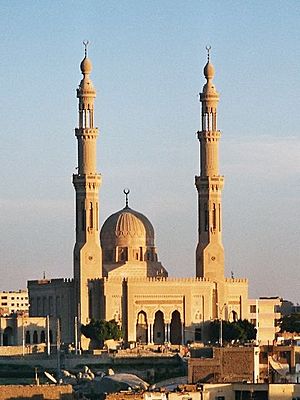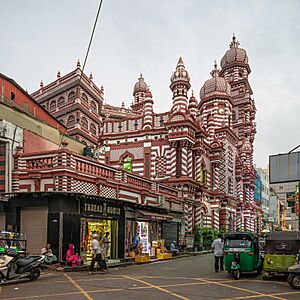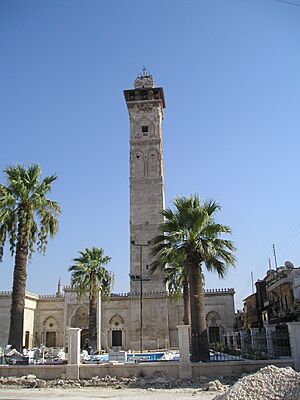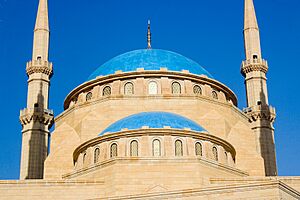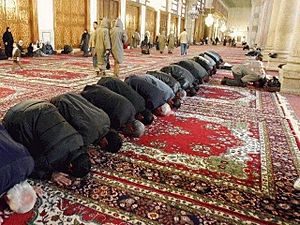Mosque facts for kids
A mosque is a special building where Muslims go to worship God (called Allah in Arabic). The word mosque comes from the Arabic word masjid. It means "a place of bowing down" in prayer. A larger mosque, used by many people, is called a masjid jāmi. These bigger mosques often offer more services to their community.
For many Muslims, a mosque is more than just a place to pray. It's a place where they can study and talk about Islam. In countries like the United Kingdom, many mosques also act as community centers. They teach about Islam and host important religious festivals and gatherings, like weddings. Mosques have rules to make sure everyone is respectful inside. For example, it's considered rude to disturb someone who is praying.
Many mosques are famous for their beautiful Islamic architecture. The very first mosques, built in the 7th century, were open-air spaces. These include the Quba Mosque and Masjid al-Nabawi. Later mosques were specially designed buildings. Today, you can find mosques on every continent, except Antarctica.
Contents
What Does a Mosque Look Like?
Many mosques are amazing examples of architecture. They often follow building styles that have been used for hundreds of years. Most mosques have large prayer halls, round domes, and tall minarets. They might also have a courtyard (an open space). Mosques are often built with walls that have beautiful patterns.
The first mosques were built on the Arabian Peninsula. The Muslims who built them used older building styles and mixed them in new ways. A big influence came from the palaces built during the Parthian and Sassanid empires in Persia. The Sarvestan palace from the Sassanid time is a good example. It has an arched entrance and a central dome, features that were common in Persia even before Islam.
After the Arab invasion of Persia, this new style, influenced by the Sassanids, spread across the Islamic world. Different types of mosques developed in various regions. Important mosque styles include the early Abbasid mosques, T-type mosques, and the central-dome mosques of Anatolia. In the 20th century, many countries that became rich from oil paid for new mosques. They often hired famous architects, even non-Muslims, to design these buildings.
Arab-Plan Mosques
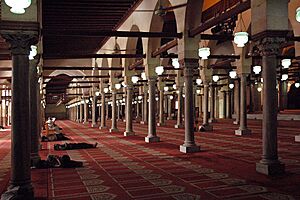
Many early mosques have a square or rectangular shape. They include a prayer hall and an enclosed courtyard. This style is called Arab-plan. The first mosques of this type were built during the Umayyad Dynasty.
The flat roof of the prayer hall was held up by many columns. This style, with many rows of columns, is called "hypostyle architecture". One of the most famous hypostyle mosques is the Mezquita de Córdoba in Spain. It has over 850 columns!
In the warm Mediterranean and Middle Eastern climates, the courtyard was useful for holding many worshippers during Friday prayers. Often, hypostyle mosques have outer arcades (covered walkways with arches). These give visitors a place to enjoy the shade. Arab-plan mosques were mostly built during the Umayyad and Abbasid dynasties. This simple style didn't allow for much change, so it eventually became less popular.
Central-Dome Mosques
The Ottomans started building central-dome mosques in the 15th century. These mosques have one very large dome right over the main prayer hall. There might also be smaller domes over other parts of the mosque. This style was greatly influenced by Byzantine religious buildings that also used central domes.
Iwan Mosques
Iwan mosques are known for their domed rooms and iwans. Iwans are spaces with an arched roof that are open at one end. One or more iwans face a central courtyard, which serves as the prayer hall. This style comes from Iranian architecture that existed before Islam. Most mosques with this style are found in Iran.
Important Parts of Mosques
Minarets: Tall Towers
Most mosques have minarets. Minarets are tall towers, usually at one of the corners of the mosque. The top of the minaret is often the highest point in the area. The tallest minaret in the world is at the Hassan II Mosque in Casablanca, Morocco.
The very first mosques didn't have minarets. Some very conservative Islamic groups, like Wahhabis, still don't build minarets. They see them as just fancy decorations and not needed. The first minaret was built in 665 in Basra during the rule of the Umayyad caliph Muawiyah I. Muawiyah encouraged building minarets because they were similar to bell towers on Christian churches. So, mosque architects used the bell tower shape for their minarets. Both minarets and bell towers serve the same purpose: to call people to prayer.
Before the five daily prayers, a muezzin calls worshippers to prayer from the minaret. In many countries where Muslims are not the majority, mosques are not allowed to play the call to prayer loudly. This is mainly because of the use of electronic sound systems, which are now common in mosques.
Domes: Heavenly Roofs
Domes are often placed right above the main prayer hall. They represent the universe that Allah created. At first, these domes were small, covering only a small part of the roof near the mihrab. Later, they grew to cover the entire roof above the prayer hall. Domes are usually shaped like a hemisphere (half a sphere). The Mughals in India made onion-shaped domes popular in South Asia and Persia. Some mosques have several domes, with one main large dome and other smaller ones.
Domes also helped the imam (prayer leader) be heard better. The sound waves would bounce inside the dome, making the voice louder.
Prayer Hall: A Space for Worship
All mosques have a prayer hall, also called musalla. Usually, there is no furniture inside, except for prayer mats or rugs. These are important because Islamic prayer often involves kneeling.
Some mosques have beautiful Arabic calligraphy and Qur'anic verses on the walls. This helps worshippers focus on the beauty of Islam and its holy book, the Qur'an, and also serves as decoration.
The qiblah wall is usually opposite the entrance to the prayer hall. This wall is specially decorated. In a mosque built correctly, it will face towards Mecca. People pray in rows facing the qiblah wall, so they are all facing Mecca. In the center of the qiblah wall is the mihrab. This is a special niche or dip in the wall that shows the direction of Mecca. The mihrab is where the imam stands to lead the five daily prayers.
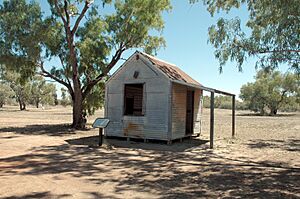
Washing Area: Getting Ready for Prayer
All people must wash themselves before they pray. Mosques often have fountains or other washing facilities near their entrances or in their courtyards. This allows people to perform the washing ritual, called wudhu, before prayer. In very small mosques, worshippers might use restrooms for their wudhu. In traditional mosques, there's often a special building just for washing, usually in the center of the courtyard. In the prayer halls, people must take off their shoes for cleanliness and respect.
Modern Mosque Features
Modern mosques often include other facilities to serve their community. These might include health clinics, libraries, and sports halls.
Inside Mosques: Decoration
-
Inside the Shah Faisal Mosque in Islamabad, Pakistan
-
Inside the Sulayman Pasha Mosque in Cairo, Egypt
-
The Nasr ol Molk Mosque in Shiraz, Iran
Inside, mosques may have decorative tiles, plaster, or colorful mosaics on the walls. You won't find any pictures or statues of people or animals inside, as this is not allowed in Islamic worship.
Religious Activities in Mosques
Prayers: Daily and Special
Adult Muslims are expected to pray five times a day. Most mosques hold formal prayers at each of these times. If someone is ill or unable to pray, exceptions are made.
Mosques also hold a special prayer service called jumuah once a week, on Friday. This is a bit like a Sabbath and replaces the regular Friday prayers. While daily prayers can be done anywhere, Muslims are expected to attend the jumuah prayer at the mosque.
When a Muslim dies, a funeral prayer is usually held. It takes place outdoors in a courtyard or square near the mosque. All worshippers present, including the imam, take part. During eclipses, mosques host special prayers called eclipse prayers.
There are two big holidays (Eids) in the Islamic calendar. On these days, special prayers are held at mosques in the morning. Larger mosques usually host these for their own communities and people from smaller local mosques. Mosques, especially in Muslim-majority countries, also host Eid prayers outside in courtyards or town squares.
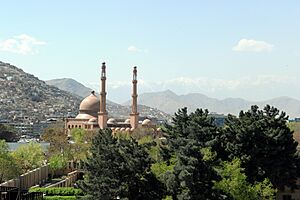
Ramadan Events
Many events happen during Ramadan, Islam's holiest month. During Ramadan, Muslims must fast during the day. Mosques organize iftar dinners after sunset, which is after the fourth daily prayer. Community members often bring food, creating nightly potluck dinners. This community contribution is important. Because of this, mosques with smaller communities might not be able to hold iftar dinners every day.
Some mosques also offer meals in the morning before dawn. Mosques often invite poorer community members to these meals. Islam sees giving charity during Ramadan as a very good deed.
Larger mosques sometimes offer special, optional prayers after the last daily prayer. Each night, someone who has memorized the entire Qur’an will recite a part of it. This can last up to two hours. Sometimes, several people take turns. During the last ten days of Ramadan, larger mosques host all-night programs to observe Laylat al-Qadr. Muslims believe this is the night the Islamic prophet Muhammad first received revelations from the Qur'an. On that night, between sunset and sunrise, mosques have speakers teach worshippers about Islam. Mosques or the community usually provide meals throughout the night.
Mosques and Community
In recent times, mosques have also become more involved in community matters. Modern mosques in Western countries aim to help Muslims be good citizens. How they do this can vary a lot from mosque to mosque and country to country.
Supporting the Community
In countries with small Muslim populations, mosques often encourage people to take part in their community. For example, American mosques host voter registration drives and encourage civic participation. In the United States, many Muslims are immigrants or their children. Mosques want to help these people get involved in community issues and stay informed about matters important to the Muslim community. People who attend mosque services regularly are often more likely to join protests, sign petitions, and get involved in political issues.
Mosques as Places of Help
It's common for smaller mosques to serve as a hostel for Muslims on haj (the pilgrimage to Mecca). Sometimes mosques are used to help refugees or as temporary homes for homeless people. In Islam, helping your neighbors is very important. The Qur'an teaches that God will help those who help others in need and those who help the oppressed. Being Muslim, or being part of a mosque community, means taking care of people who need help. A mosque is a social group as well as a religious one.
A madrassa is a bit different from a mosque. A madrassa focuses on teaching Islam, usually to children and young people.
Rules and Behavior in Mosques
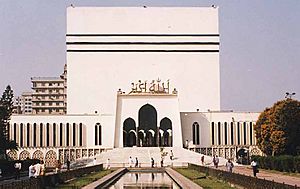
In a mosque, people should focus on worshipping Allah. Because of this, there are rules about how to behave. Some rules are the same everywhere, like not wearing shoes in the prayer hall. Other rules might be different from mosque to mosque.
Prayer Leader: The Imam
It's generally good to have someone lead the prayers, though it's not always strictly necessary. The person who usually leads the prayers is called an imam. He should be an honest man and knowledgeable about religious questions. In mosques supported by the government, the imam is chosen by the ruler. In private mosques, the community chooses the imam by voting.
Only men can lead prayers for groups of men. Women are allowed to lead prayers only for groups where there are only women.
Attending a Mosque
Besides washing, there are other rules for anyone entering a mosque, even if they don't plan to pray. It is forbidden to wear shoes in the carpeted area of the prayer hall. Some mosques also don't allow shoes in other parts, even if they are not for praying.
Islam requires its followers to wear clothes that show modesty. So, both men and women must follow this rule when they go to a mosque. Men should wear loose, clean clothes that don't show their body shape. Women are expected to wear loose clothing, shirts, pants that cover their wrists and ankles, and cover their heads, for example, with a hijab. Many Muslims, from different backgrounds, wear Middle Eastern clothing for special occasions and prayers at mosques.
Mosques are places of worship. So, everyone inside should be respectful to those who are praying. Loud talking or discussing topics that could be disrespectful is not allowed in prayer areas. It's also considered rude to walk in front of Muslims who are praying or to disturb them in any way.
Separate Areas for Men and Women
Islamic law requires men and women to be separated in the prayer hall. Ideally, women should pray behind men. The second caliph Umar once stopped women from attending mosques, especially at night, because he worried they might be bothered by men. So, he encouraged them to pray at home. Sometimes, a special part of the mosque was separated for women; for example, the governor of Mecca in 870 used ropes to create a separate space for women.
Today, many mosques place women behind a barrier or partition, or in a separate room. Mosques in South and Southeast Asia have separate rooms for men and women, as these divisions were built centuries ago. In nearly two-thirds of American mosques, women pray behind partitions or in separate areas, not in the main prayer hall. Some mosques do not allow women at all. However, the Grand Mosque in Mecca has sections only for women and children, but the main area is open to all.
Non-Muslims in Mosques
Some Islamic law scholars believe that non-Muslims can be allowed into mosques, as long as they don't sleep or eat there. Followers of the Maliki school of Islamic law disagree. They say non-Muslims should not be allowed into mosques at all.
Different countries have different views on this. Almost all mosques in the Arabian Peninsula and Morocco do not allow non-Muslims. The Hassan II Mosque in Casablanca is one of only two mosques in Morocco currently open to non-Muslims.
In modern Saudi Arabia, the Grand Mosque and all of Mecca are open only to Muslims. Also, the Masjid al-Nabawi and the city of Medina around it are off-limits to non-Muslims. For mosques in other areas, it's generally understood that non-Muslims can enter if Muslims give them permission and if they have a good reason.
In modern Turkey, non-Muslim tourists are allowed to enter any mosque, but they must follow rules of decorum. Visitors can only enter between prayers. They must wear long trousers and take off their shoes. Women must cover their heads. No photos, no loud talking, and no signs of other religions (like crosses on necklaces) are allowed.
However, in many places in the West and the Islamic world, non-Muslims are welcome to enter mosques. Most mosques in the United States, for example, report having non-Muslim visitors every month. Many mosques in the United States welcome non-Muslims to show openness to the community and to encourage people to learn about Islam.
Dogs in Mosques
Dogs are usually not allowed in mosques. But on September 24, 2008, the Muslim Law Council UK made a special ruling, called a fatwa, which allowed a blind Muslim to bring his guide dog into the mosque.
Mosques in Spain
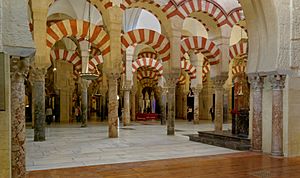
When Spain was under Muslim rule, some of the most beautiful buildings were mosques. After 1491, Spain came under Christian control. However, the Christians did not tear down the mosques. Instead, they simply added a crucifix to them and turned them into churches. These former mosques influenced the Renaissance architecture (way of building) in Europe.
Images for kids
-
The Blue Mosque in Istanbul, Turkey.
-
The Namazgah Mosque in 2018. Once finished, it will be the largest mosque in the Balkans.
-
The Faisal Mosque in Islamabad is the largest mosque in Pakistan and South Asia, holding up to 300,000 people.
-
The Hagia Sophia in Istanbul, Turkey, became a mosque after the Ottoman conquest of Constantinople in 1453.
-
Iftar at Taipei Grand Mosque, Taiwan during Ramadan.
-
Vault ceiling of the Nasir al-Mulk Mosque in Shiraz, Iran.
-
Adina Mosque, once the largest mosque in South Asia, in Pandua, the first capital of the Bengal Sultanate.
-
Huseina Čauša džamija (also known as Džindijska), a 17th-century traditional wooden mosque in Tuzla, Bosnia and Herzegovina.
-
Mihrab in Al-Masjid an-Nabawi, Medina, Saudi Arabia.
-
The oldest standing minaret in the world at the Great Mosque of Kairouan, Tunisia.
-
The 201 Dome Mosque in Tangail District, Bangladesh.
-
Evening praying at the Lahti Mosque in Lahti, Finland.
-
President George W. Bush inside the Islamic Center of Washington D.C., US.
-
The East London Mosque was one of the first in Britain allowed to use loudspeakers to broadcast the adhan (call to prayer).
-
2010 Aerial view of the largest mosque in the world, The Sacred Mosque (Al-Masjid Al-Ḥarām) of Mecca in the Hejaz region of Saudi Arabia, with the Kaaba in the center.
-
Islam's second holiest site, Al-Masjid an-Nabawi (The Prophet's Mosque) in Medina.
-
The Umayyad Mosque built by the Umayyad Caliphate.
-
The Mosque of the Companions (Masjid As-Sahabah) in Massawa, Eritrea, Horn of Africa.
-
Masjid al-Qiblatayn (Mosque of the two Qiblahs) in Medina.
-
The hypostyle prayer hall in the Great Mosque of Kairouan, Tunisia.
-
A wooden prayer hall of the Järvenpää Mosque in Järvenpää, Finland.
-
Kursu in Čaršija mosque in Zenica, Bosnia and Herzegovina.
-
Ulu mosque in Utrecht, Netherlands.
See also
 In Spanish: Mezquita para niños
In Spanish: Mezquita para niños


